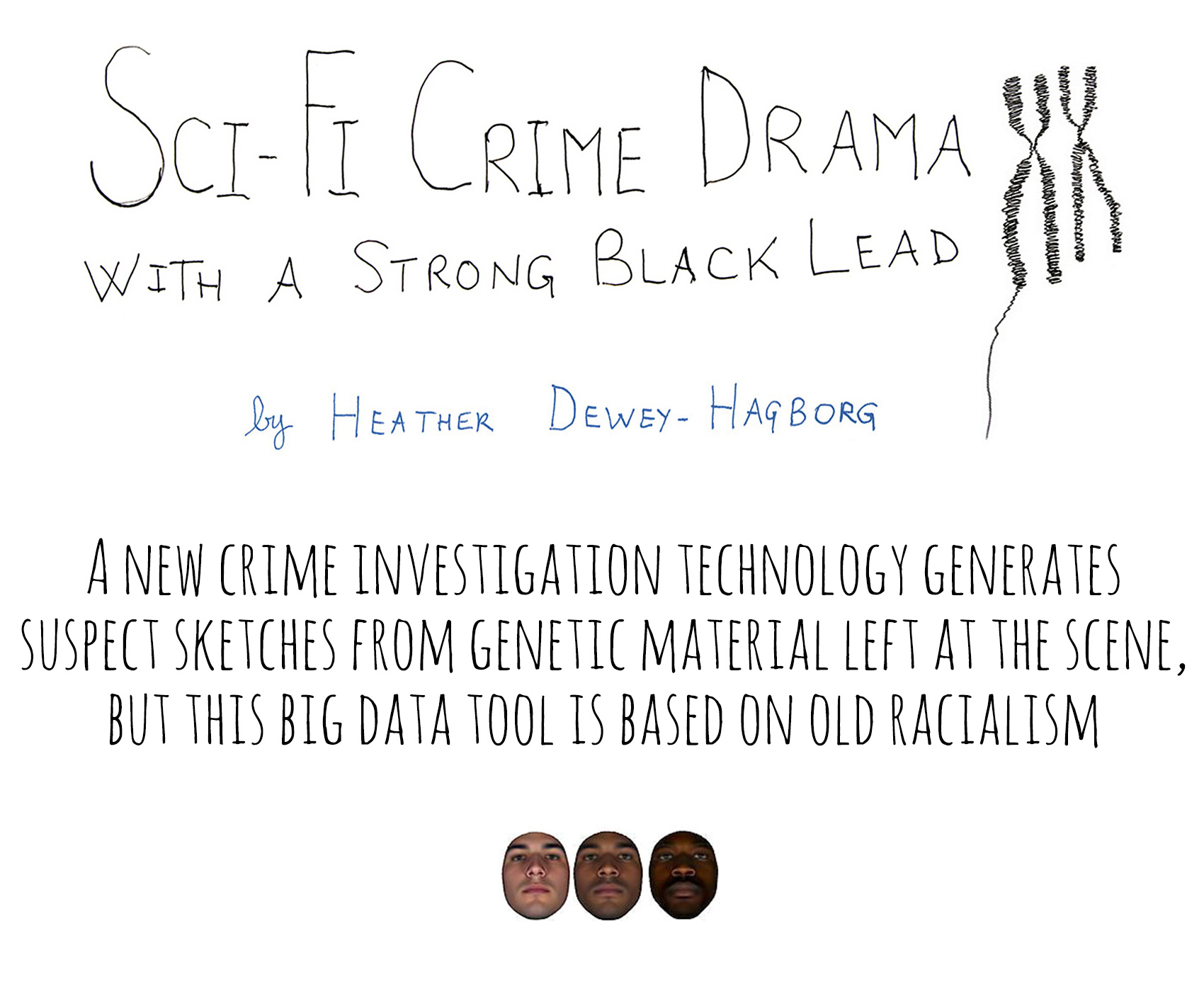
The practice of rendering appearance from forensic samples is called “Forensic DNA Phenotyping” (FDP) or “molecular photofitting," and there are a handful of scientists and companies around the world trying to make this not only scientifically possible, but also a useful law enforcement tool. FDP has already been used to create a new kind of police sketch.
While there are a few traits like eye and hair color that can be predicted from DNA with a high degree of certainty, the bulk of FDP relies on algorithmically derived statistical composites. We tend to look at technical systems as neutral black boxes, but if you open them up and look at the component parts, you find that they reflect the assumptions and motivations of their designers.
FDP begins with a dataset of 3D facial scans and DNA samples taken from research participants. These scans are processed to create what’s called “face space,” a probabilistic representation of all possible faces drawn from, and limited by, this set of 3D scans. Finally, the data is mined for correlations between DNA and facial shape by examining characteristics that are assumed to be opposite ends of a spectrum, like masculine and feminine or “European” and “African.”
The act of creating computational averages and looking for correlated features in large datasets has an air of authenticity and scientific validity, but what this actually does is create a system of types -- you might call them stereotypes.
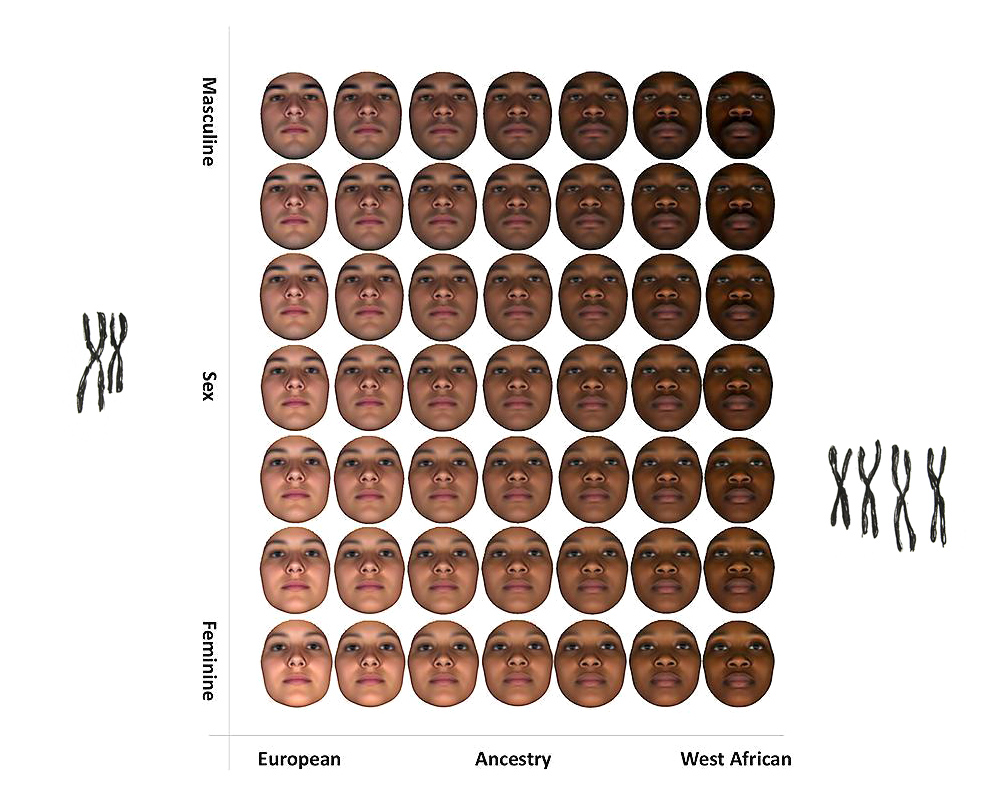
The “face space” of Gender and Ancestry as represented in Forensic DNA Phenotyping
From 2012 to 2013 I obsessively collected shed hairs, smoked cigarette butts, chewed up gum, and fingernails to research just how much I could learn about the people who had dropped them. What I discovered was that by combining an arsenal of published research, bioinformatics, and machine learning tools, I could draw inferences or statistical predictions about what these individuals looked and acted like, what kind of health conditions they had, and even what their last names were. In my art project Stranger Visions I appropriated and interpreted a subset of these techniques to create life-size full-color 3D portraits of the strangers whose DNA I had collected.

Stranger Visions, 2012-13
My immediate goal with this project was to create a public dialogue concerning the emergent possibility of genetic surveillance. At the time, many in the media dismissed this notion as science fiction, but this is no longer a speculative future, it's a worrying present. As these technologies move rapidly from research to deployment by law enforcement agencies around the world, they deserve scrutiny all the way down to the algorithmic level.
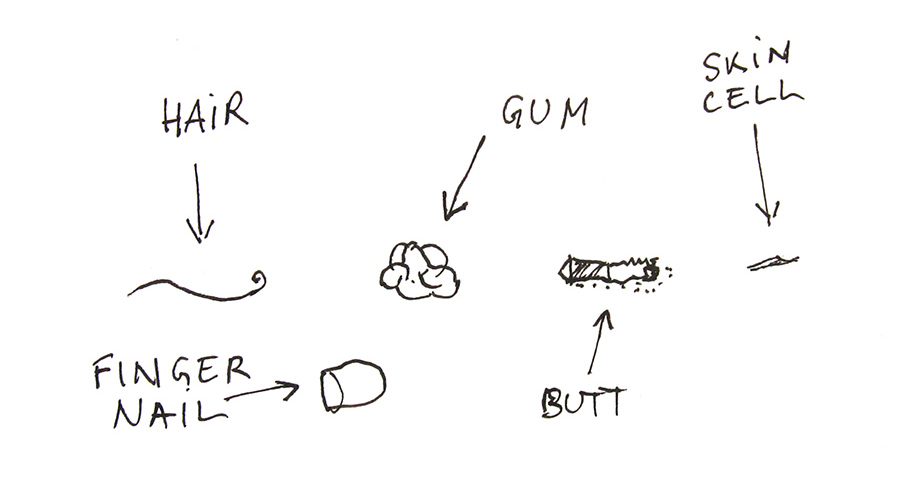
Compositing is not new. It goes back to Francis Galton, cousin to Charles Darwin, popularizer of the fingerprint as a mode of identification, and an infamous eugenicist. He took lots of images and composited them to find types. Types like: the violent criminal, the thief, the diseased, and the Jew.
He also used this technique to find “ideals,” the norm against which deviance could be judged. These were types that we would all agree are unassailable, like “scientists.”
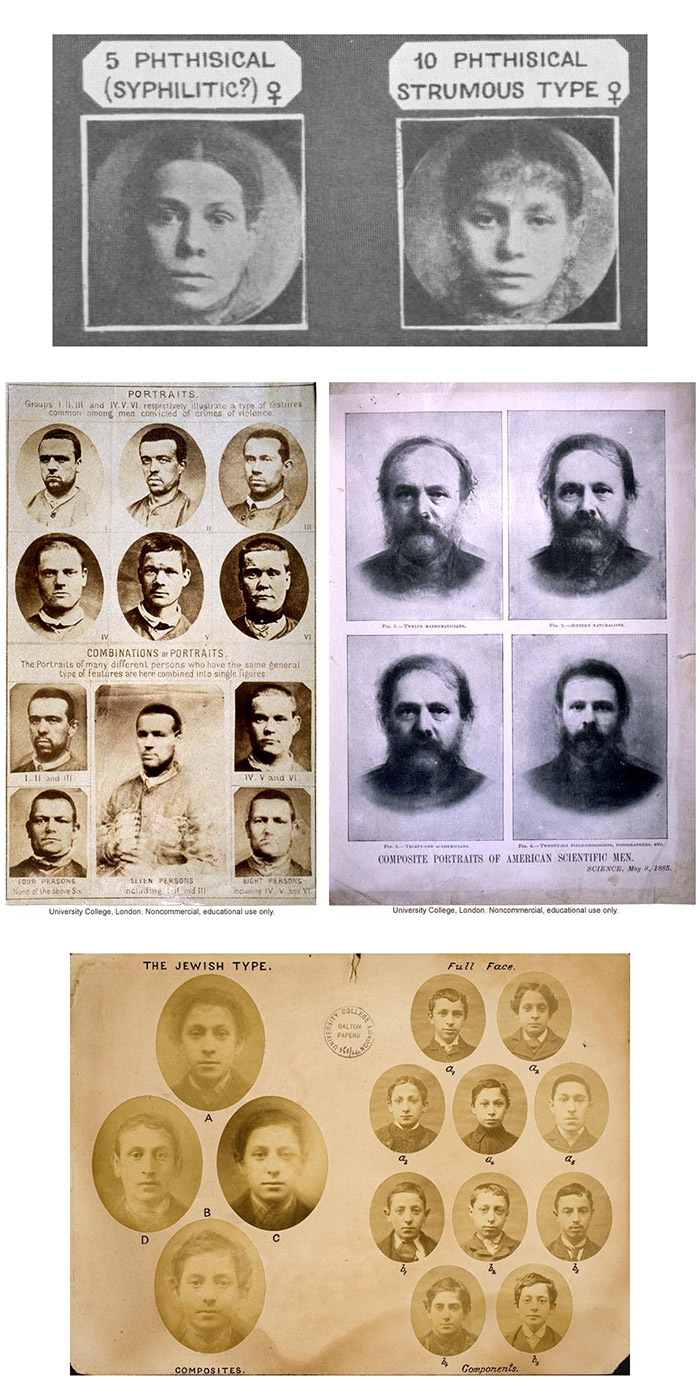
Galton’s work built on existing beliefs that humans could be categorized into groups based on physical features. These ideas stemmed from what are now viewed as archetypically pseudoscientific studies of physiognomy, phrenology, and anthropometry. By the late 19th century, physical measurement, description, and imaging techniques were widely used to read types from the body ranging from race to moral character.
Despite having been discredited, the same tables of anthropometric measurement that were used for categorizing races in the 19th century are still used in forensic anthropology, plastic surgery, and facial recognition – the latter of which informs the algorithms that allow for facial parameterization in FDP. Forensic DNA Phenotyping is simply the latest in a long succession of identity-inscribing technologies which claim to use science to classify types of bodies into socially constructed categories like gender and race.
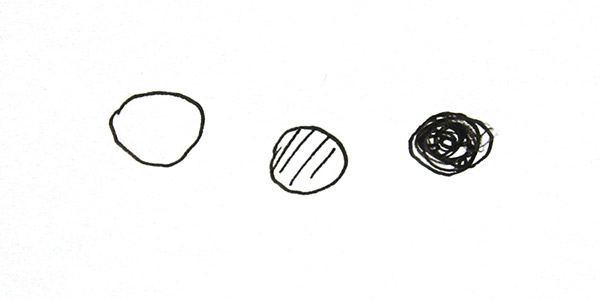
Forensic DNA Phenotyping has been making headlines recently as the company Parabon Nanolabs began offering a service to law enforcement in December of 2014 called “Snapshot,” which it claims "produces a descriptive profile from any human DNA sample,” predicting “physical characteristics including skin pigmentation, eye and hair color, face morphology, sex, and genomic ancestry.”
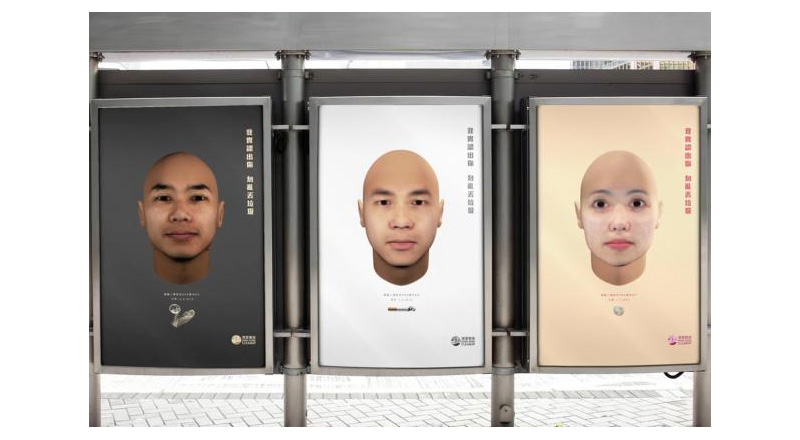
Hong Kong Cleanup “Face of Litter” campaign, 2015
You may have seen the “wanted posters” they produced recently with the ad agency Ogilvy and the anti-littering group Hong Kong Cleanup, where they extracted DNA from litter and analyzed it to create portraits of the alleged litterers.
The future I imagined with Stranger Visions is our disturbing present. There are a number of obvious concerns this technology raises in a forensic context.
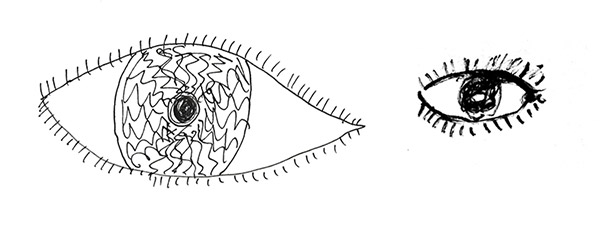
Accuracy is everyone’s first concern.
The New York Times conducted an “unscientific study” by commissioning FDP portraits of two of their journalists and asking for guesses as to their identities. One was an older male of Jewish ethnicity, the other a younger female of Korean and European ancestry. While several people were able to accurately identify the female, no one correctly recognized the male.
How valid are these DNA-derived portraits? How much do they resemble the DNA donor? My own research and the New York Times article would seem to indicate the answer is “Not very.”
Or more precisely, it may be accurate, to the extent that the individual resembles an average representation of their genetic traits and ancestry as it has been represented within the training data. Furthermore, FDP cannot account for age, environmental influence on gene expression, an individual’s decision to embrace a non-biologically determined identity, or to modify their appearance through diet, hair color, contact lenses, makeup, hormones, or plastic surgery.
Really, we don’t know how accurate it is. We don’t even have an accurate way to test its accuracy.
One of the reasons it’s difficult to be certain about this technology’s accuracy is that it is completely closed-source. While they have announced plans to collaborate on a peer-reviewed validation study, as of now Parabon has not disclosed or published any of their research. I can only assume that they are drawing on existing publications and frameworks defined by scientists like Manfred Kayser and biological anthropologists like Mark Shriver who have published widely on the subject. There currently appear to be no legal regulations governing the use of unvalidated forensic technologies in the exploratory phase of an investigation. Parabon claims it’s “more accurate than one might think,” but can we really take their word for it?

Another area of frequent concern is privacy and the potential invasiveness of this technology. Until now, with the exception of sex, the vast majority of forensic DNA profiling analyzed only non-coding DNA -- the parts of a DNA sequence that don’t translate into anything physical. Subsections of non-coding DNA are highly variable. They tend to be different between unrelated people, and can therefore be used to identify individuals with a very high probability.
Forensic DNA Phenotyping represents a major shift in its potential to analyze not only what are considered “externally visible characteristics” -- things an eyewitness could presumably glean from an encounter like sex, hair color, eye color, skin color, and controversially ancestry or race, but also traits like propensities for disease, behavioral characteristics, sexual orientation, intelligence, religion, all of which scientists have since Galton been attempting (however dubiously) to link to genetics.
The disclosure of a predisposition to devastating illness is of obvious concern, but even ancestry calculation holds the potential to “reveal” histories that may contradict people’s self-understanding and question long-held ethnic and cultural affiliations.
Keep in mind the individual whose DNA is being profiled is at this stage merely a “person of interest” and they may very well not have committed any crime.
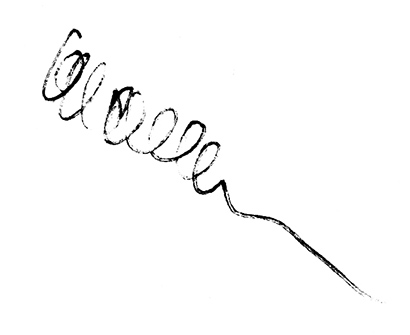
While concerns over the accuracy and invasiveness of the technology are important, the primary fear I have is that the technology available today masks a form of gender and racial stereotyping with the scientific authority of genetics.
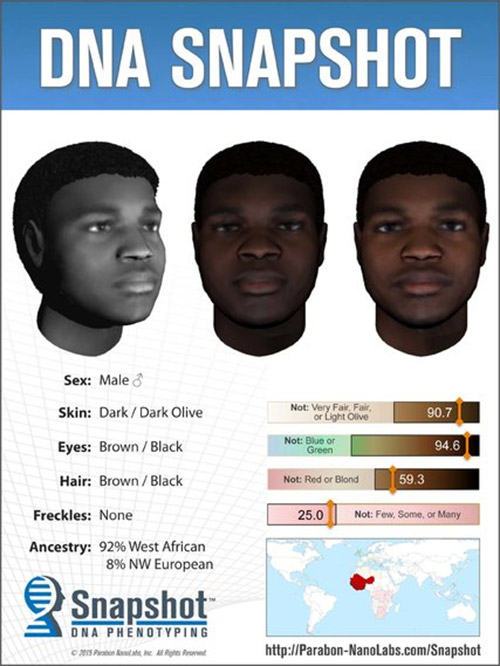
DNA police sketch produced by Parabon Nanolabs
The image above is the profile Parabon created for the police in Columbia, South Carolina. It’s allegedly the first “DNA police sketch” ever deployed in an actual criminal investigation -- a double homicide cold case from 2011. While the profile was released in January 2015, the case remains unsolved.
Look closely at this profile and the details being offered about the individual’s appearance: Male with dark skin, eyes and hair. Ninety-two percent West African and eight percent North Western European. There are no descriptors here of specific facial features. This is a generic portrait of an African American male, a visualization of a stereotype derived from scientist’s social and statistical assumptions.
Forensic DNA Phenotyping is premised on the calculation of what is called genomic ancestry, admixture, or Biogeographical Ancestry (BGA) -- friendlier terms for what are commonly understood as racial percentages and referred to as “the heritable component of race.” After assigning sex, the second step in creating a DNA phenotype is to assess an individual’s percentages on roughly four “ancestral" types: African, European, Native American, and East Asian; a division which recapitulates the centuries-old racial categories of Caucasian, Mongoloid, and Negroid.
This categorization is performed by examining a panel of Ancestry Informative Markers (AIMs), individual base pairs selectively culled from an estimated 15 million Single Nucelotide Polymorphisms (SNPs) scattered throughout the genome. These points of commonly occurring DNA variation are the foundation for a geographical spectrum that will lead to the “face space.” AIMs are correlated with specific populations and are used for admixture mapping or determining the level of “interbreeding" between "geographically separate populations." They are used primarily by scientists researching personalized medicine and FDP.
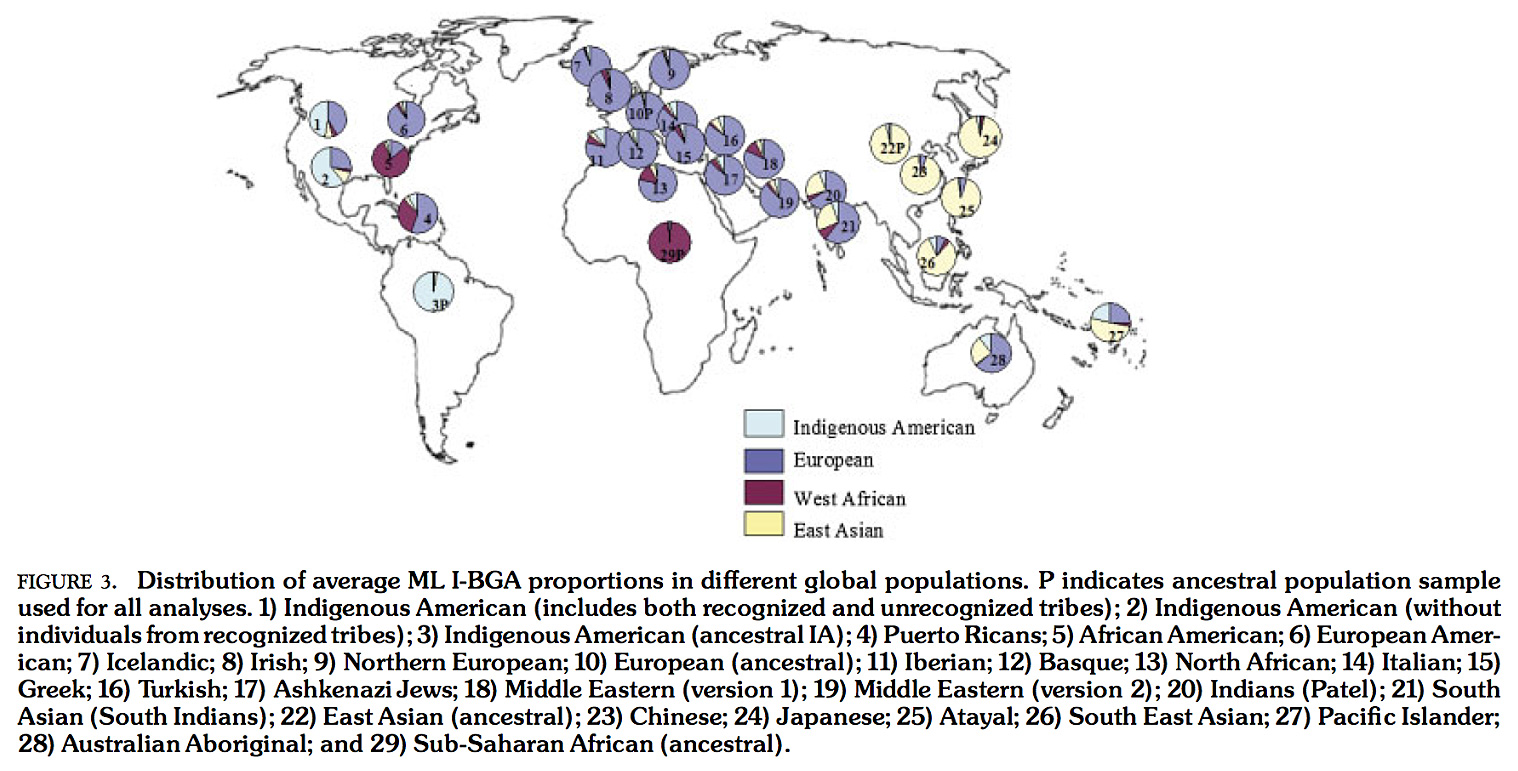
Figure from Halder, Indrani, Mark Shriver, Matt Thomas, Jose R Fernandez, and Tony Frudakis. “A Panel of Ancestry Informative Markers for Estimating Individual Biogeographical Ancestry and Admixture from Four Continents: Utility and Applications.” Human Mutation 29, no. 5 (May 2008): 648–58
This is similar to the technology used by commercial companies like 23andMe that offer direct-to-consumer genetic ancestry testing, though commercial companies also examine mitochondrial (mtDNA) and Y chromosomes (Y-DNA). Because these types of DNA are inherited directly from mother to offspring (mtDNA) or father to male offspring (Y-DNA) without recombination, they can be used to trace maternal or paternal lineages along one ancestral branch, i.e. your mother’s female ancestry or if you have a Y chromosome, your father’s male ancestry.
While mtDNA and Y chromosome DNA can provide an interesting path through ancestral history, they don’t provide an overall view of an individual’s constitutive racial percentages. Because of this, they are of limited use for phenotyping, which maps an individual to a generic racial face-type. This is where BGA, AIMs, and the racial percentages they purport to calculate come in. Biogeographical ancestry quantification forms the fundamental basis of FDP composite portraiture. Sex and ancestry percentages combine to create a kind of stereotyped “base face,” which is then further permuted by traits like eye color, hair color, freckling, and a small but variable degree of facial shape modification based on genotype. Depending on the facial data and algorithms used to create the software system, different possible portraits will emerge from the DNA data.
As an analogy, think of a predicted phenotype like your taste profile on Netflix, Spotify, or a similar content service. Both use statistics and machine learning on a database of user profiles to cluster, classify, and make predictions about users. Depending on what the service is licensed to stream, the content you want may or may not be present. To the extent that your taste deviates from some mainstream norms or predictable patterns you will be hard to profile, and the service may make suggestions you don’t like. Similarly with a phenotype, to the extent that an individual’s appearance deviates from predictable gender and ancestral types defined in the input data used to create the model, it will be difficult to predict.
It’s not so much that the technology is inaccurate, it’s that it is reductive, like so many algorithms shaping our lives today. To the extent that an individual is around 30 years old and looks to the viewer like the generic representation of their sex, ancestry, and traits as they are represented in the software, they may well look very much like their DNA phenotype.
Then again, they may not.
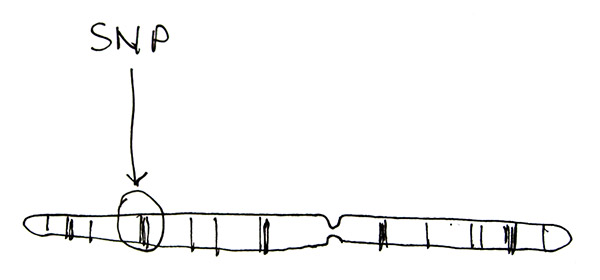
The concept of biogeographic ancestry developed for FDP and the racial typology it implies is not neutral. It was designed specifically to be instrumental for police in the United States looking to assign a racial category to an unknown suspect from a forensic sample. It is derived from, embodies, and delivers a very specific racial typology.
It is important to emphasize here that Ancestry Informative Markers do not "code for race.” AIMs are not genes and they do not produce phenotypes. This is correlation not causation; it is predictive, not diagnostic. The model is premised on the idea that contemporary individuals with all four grandparents originating (for example) in Africa or a Native American community can be held up to represent a unified “ancestral” population that is then differentiated from Europeans by a handful of basepairs.
Anthropologist Duana Fullwiley points out that this US and Eurocentric view of history naturalizes two timeframes: the present, and an ancestral past before colonial expansion, the point at which it is imagined "population mixing" began. This moment could be reframed as the time at which Europeans encountered populations they deemed as other, and proceeded to enslave, rape, and commit genocide against them. This is when it is imagined continental “inter-breeding” began, before which populations were “pure,” not admixed.
Thus we can see that despite the popular refrain that there is "no genetic basis for race" which emerged in the wake of the Holocaust and was reiterated at the completion of the Human Genome Project, scientists have been all the while calculating frequencies to create associations between different genetic profiles that they say have nothing to do with race, and then contrasting these profiles according to existing ethnic and racial groups. Though race doesn’t exist at the genetic level, scientists can still create it by correlating large genetic datasets into classic racialist categories. This desire to find correlations pointing to race while simultaneously denying its existence is what sociologist Troy Duster calls the "molecular reinscription of race."
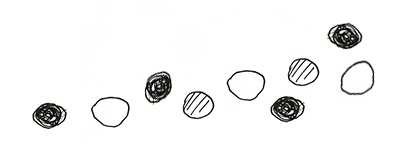
Race is socially constructed. This means there is no biological basis for categorizing humans into types like white and black. “Black” and “white” take on meaning in human communities. It means the human species is one coherent whole, characterized by its genetic similarity rather than its difference. There is no gene, or set of genes, that code for black or white. These racial concepts are human-defined constructs with political histories that vary regionally and shift over time in accordance with cultural views, including the popular science of the day. This understanding is uncontested among serious geneticists.
Biogeographical ancestry encourages racial thinking by presupposing that race is useful (i.e. to the police) and can be accurately assessed from genetic trace evidence. It relies on the social definition of a phenotype, while claiming a biological basis for ancestry and human difference more generally, blurring population genetics and racial science. Because BGA presupposes a four-continent model of ancestry stemming from centuries of scientific racism, systems that build further upon this foundation, like FDP, reinforce these biases.
When biology presupposes and then purports to discover ancestral categories through data-mining, it bolsters the view that there is a biological basis for race, which segues quickly into more broadly racist thinking. It is this very research that retired New York Times science writer Nicholas Wade infamously cited in his 2014 book A Troublesome Inheritance to claim that gaps in human achievement and intelligence can be explained by racial differences grounded in biology. While many of the scientists whose work he drew on quickly denounced him, the book was a bestseller. A 2014 US survey showed that by framing race as genetic, direct-to-consumer admixture tests reinforce the idea that race is a biological reality and “increase beliefs that whites and blacks are essentially different.”
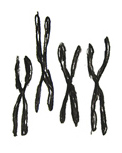
The American Civil Liberties Union defines the practice of racial profiling as “the discriminatory practice by law enforcement officials of targeting individuals for suspicion of crime based on the individual's race, ethnicity, religion or national origin.” After years of debate, racial profiling has been widely discredited and rejected by the public. While a recent justice department ruling banned racial profiling for federal law enforcement, it remains a common policy among local police, border patrol, and airline security screeners.
It is not difficult to imagine how the vague racial images and descriptions FDP produces (ie. "dark skinned 92 percent african 8 percent european male”) could be used by police as a "scientifically legitimate" excuse to justify racial dragnets. Furthermore, given the general low level of mathematical and scientific literacy in the population at large, it seems unlikely education of the end-users (police) will be sufficient to enable adequate interpretation of this complex information, its probabilistic nature, and the inherent uncertainties involved.
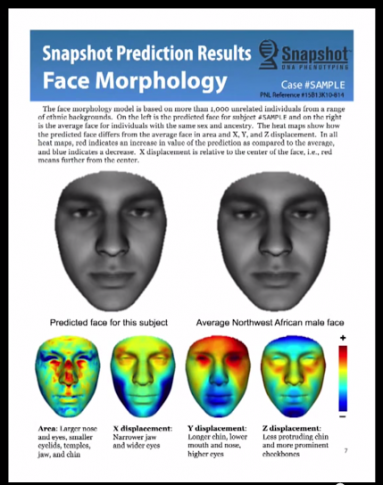
Still from Parabon Nanolabs promotional video
Because forensic DNA phenotyping and biogeographical ancestry carry the authority of science, they seem more objective than an eyewitness. Some commentators have even argued that these methods may combat the existing racial bias and general unreliability in eyewitness reports. But the prospect that FDP could be more accurate and reliable than a human witness assumes that race and gender are biological, that they can be measured and quantified with certainty, that a person is likely to look like stereotyped representation of their traits as defined by a particular software system, and that that stereotype will align with the biases of the local culture in which it is deployed.
These technologies black-box their stereotypes, hiding them in the algorithms. If you or I, or the police, or a corporate service enter DNA data into software and get racial percentages as output, the act of stereotyping is displaced. It isn’t us, it’s the system. The process doesn’t appear biased because the bias is coded in the program.
Rather than make police procedure fairer, forensic DNA phenotyping threatens to undermine decades of protest, education, and agitation for policy reform to end racial profiling, institutional racism, and discrimination. The implications here are not theoretical, abstract, or probabilistic, they are human lives, and they are disproportionately black lives. Rick Kittles, the geneticist behind africanancestry.com, recently told Duana Fullwiley that he had stopped sharing DNA with the scientists developing FDP systems because “I don’t want to help them put more black people in jail.”
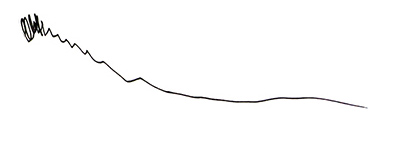
As I’ve examined forensic DNA phenotyping closely and deconstructed its underlying logic, I’ve found a set of problematic assumptions. The assumption that identity is biological, and that characteristics like gender and race can be read from the body, quantified with percentages, labeled as typologies, and transformed into visible characteristics. The assumption that a set of stereotyped representations of race and gender reflect the categories assigned by their coder. The assumption that pure, unadmixed ancestral populations have ever existed, and exist now in contemporary populations.
There are other ways of approaching phenotyping that yield less dramatic results but are firmly rooted in genetics instead of stereotyping. But even the most scientifically grounded and ethically implemented approach to phenotyping will always be inherently limited, as the genotype/phenotype relationship is a complex one modulated by interaction with the environment, age, lifestyle, injury, and self-modification. And as Parabon states in their FAQ, their technique cannot parse DNA mixtures, a common circumstance where a forensic sample is contaminated with another individual’s DNA.
If we are indeed entering a future of genetic surveillance, it is the complexities, limits, biases, and weaknesses of these new technologies we need to excavate. To do so, we need a multifaceted and transdisciplinary approach blending art, science, theory, and hands-on experimentation. The media will talk about how it all works, but to fully understand, to appropriately educate others, to devise suitable policies, and to form strategies of resistance, we need to know how it breaks.
Heather Dewey-Hagborg is a transdisciplinary artist and educator who is interested in art as research and critical inquiry

Duster, Troy. “A Post-Genomic Surprise. The Molecular Reinscription of Race in Science, Law and Medicine: A Post-Genomic Surprise.” The British Journal of Sociology 66, no. 1 (March 2015): 1–27.
Ewen, Elizabeth, and Stuart Ewen. Typecasting: On the Arts & Sciences of Human Inequality. New York: Seven Stories Press, 2006.
Finn, Jonathan M. Capturing the Criminal Image: From Mug Shot to Surveillance Society. Minneapolis, Minnesota: University of Minnesota Press, 2009.
Fullwiley, Duana. “The ‘Contemporary Synthesis’: When Politically Inclusive Genomic Science Relies on Biological Notions of Race.” Isis 105, no. 4 (December 1, 2014): 803–14.
Fullwiley, Duana. “Race, Genes and Power.” The British Journal of Sociology 66, no. 1 (March 2015): 36–45.
Jones, David S., and Ian Whitmarsh. What’s the Use of Race? Modern Governance and the Biology of Difference. Cumberland, RI, USA: MIT Press, 2010.
TallBear, Kim. Native American DNA: Tribal Belonging and the False Promise of Genetic Science. Minneapolis, MN: Univ Of Minnesota Press, 2013.
Wailoo, Keith, Alondra Nelson, and Catherine Lee. Rutgers Studies on Race and Ethnicity: Genetics and the Unsettled Past: The Collision of DNA, Race, and History. Piscataway, NJ, USA: Rutgers University Press, 2012.
For more on methods of DNA counter-surveillance see my projects: Invisible, Biononymous.me & DNA Spoofing







